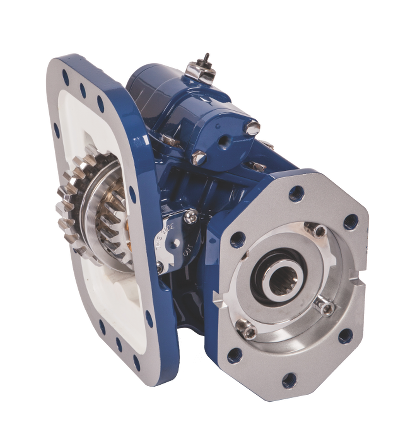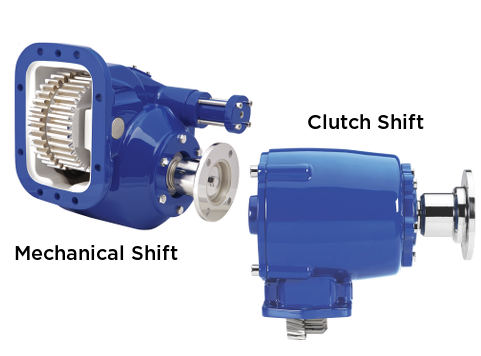What Do You Need to Know to Specify a PTO?
Proper power take-off (PTO) selection requires specific knowledge of the vehicle’s transmission and the driven component. With this information, selection is a relatively simple process.
So, what do you need to know?
- Transmission make and model number
- This can be found on the manufacturer’s tag on the transmission itself or, with a new vehicle, on the build sheet. Dealers may also be able to identify the transmission through the vehicle identification number (VIN).
- Which aperture will the PTO be mounted?
- This is generally dependent on the available space around the PTO aperture (i.e. the PTO opening space). Be sure to note the presence of exhaust pipes, spring hangers, air tanks, etc.
- The speed requirement of the driven component and or the desired PTO percentage.
- If the PTO is being used to power a hydraulic pump it is common to specify a PTO percentage of 90 to 120 percent.
- The required direction of rotation of the PTO shaft.
- The torque and horsepower requirement of the driven component.
- This will often determine the PTO series to be used.
- If the driven component is to be a direct-coupled hydraulic pump, the mounting face, and shaft dimensions of the pump.
 The method by which the PTO will be engaged.
The method by which the PTO will be engaged.
POWER TAKE-OFF MODEL NUMBER SAMPLE:
TG8S-U6807-A1KX
TG – Triple Gear Series
8S – 8-bolt mounting
U68 – Input gear designator
07 – Internal gear ratio of .7:1
A – Air shift
1 – Assembly arrangement
K – Output shaft designator
X – Special feature designator
PTO TORQUE AND HORSEPOWER REQUIREMENTS
In addition to meeting the speed and rotational requirements of the driven component, the PTO must also meet the torque and horsepower requirements of the application. This information can usually be found in the owner’s manual of the equipment or by contacting the manufacturer or distributor. There are also mathematical formulae that can be used to calculate these requirements.
The most common application for a PTO is to provide power to a hydraulic pump. If the flow and pressure requirements of the hydraulic system are known, the horsepower requirement can be calculated by the formula:
HP = GPM × PSI ÷ 1714 ÷ Pump Efficiency (Example: 25 GPM × 2000 PSI ÷ 1714 ÷ 90% = 32 HP)
The torque load placed on the PTO can then be determined by the following formula:
T = HP × 5252 ÷ RPM
Note: In the above formula the RPM figure is the PTO shaft speed, not the engine speed.
So, the torque load on the PTO in the example, if the PTO shaft speed were 1200 RPM, would be 32 × 5252 ÷ 1200 = 140 lb.ft.
In mechanical applications where the PTO is supplying power directly to a driven component, the RPM and horsepower requirements must be obtained from an owner’s manual, or specification sheet, or by contacting the manufacturer or distributor of the component.
All PTOs have torque and horsepower limitations. With the Muncie Power Products Quick Reference Catalog, for instance, these can be found on the application pages. It is important to remember two things about the published torque and horsepower ratings in Muncie Power’s catalog:
- Horsepower is directly proportional to PTO output shaft speed and the published ratings are at 1000 RPM. A PTO is rated at 40 HP at 1000 RPM; therefore, it can deliver 80 HP at a shaft speed of 2000 RPM, but only 20 HP at a shaft speed of 500 RPM.
- Torque is constant. The torque rating shown is the maximum at any shaft speed and is calculated to provide a minimum of 300 hours of life, at continuous service, at that torque level.
RELATED: How to use the PTO Builder

TYPES OF POWER TAKE-OFFS
There are two broad types of PTOs: mechanical shift and clutch shift.
Mechanical PTOs are those that are engaged when gears slide into mesh with each other. Since a PTO is essentially a non-synchronized gearbox, it is important that the operator make certain that the transmission gears stop turning before engaging the PTO. Engaging a mechanical PTO with the transmission gears turning will result in PTO and or transmission damage.
Mechanical PTOs are commonly engaged by means of a lever, cable, or air pressure, and are typically found on manual transmissions. Muncie Power’s TG Series is the most popular mechanical shift PTO. Other Muncie Power model series of this type are the SH Series and 82 Series.
On the other hand, the most common PTO found on an automatic transmission is a clutch shift PTO. Rather than engaging by means of a sliding gear, the clutch shift PTO utilizes clutch disks and friction plates to engage. When hydraulic or air pressure is applied to an internal piston the clutch disks and friction plates are forced together, engaging the PTO. Since there is no possibility of gear clash, this type of PTO can even be engaged with the vehicle in motion (as long as the truck engine speed remains under 1000 RPM). Muncie Power’s clutch shift PTO series includes the A20 Series, CS10/11 Series, and CS41 Series models.
MUNCIE POWER PRODUCTS PTO APPLICATION ASSISTANCE
 Muncie Power can help you determine the correct PTO model to meet your requirements. Our user-friendly, online product specification software program—the PTO Builder—is easily accessible, and the Customer Service Department is available at 1-800-367-7867.
Muncie Power can help you determine the correct PTO model to meet your requirements. Our user-friendly, online product specification software program—the PTO Builder—is easily accessible, and the Customer Service Department is available at 1-800-367-7867.


